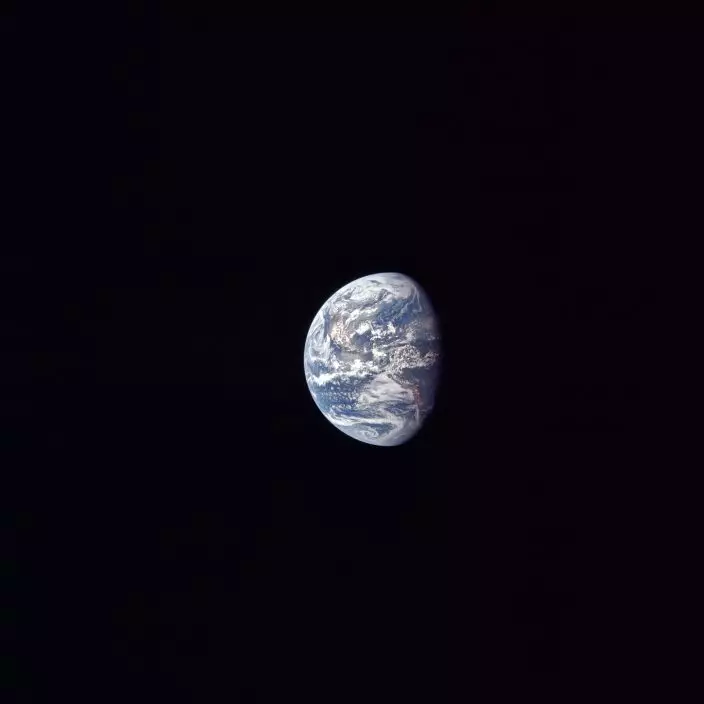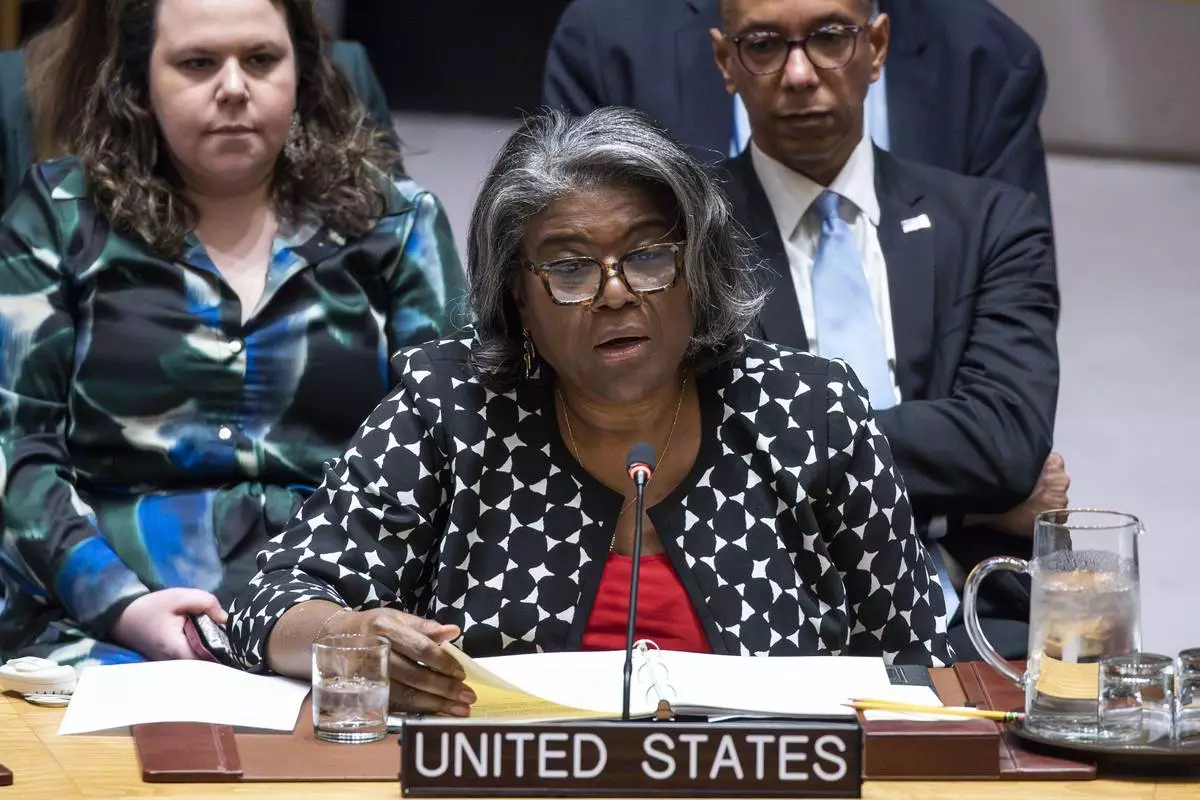In 1964, Stanley Kubrick, on the recommendation of the science-fiction author Arthur C. Clarke, bought a telescope.
"He got this Questar and he attached one of his cameras to it," remembers Katharina Kubrick, the filmmaker's stepdaughter. "On a night where there was a lunar eclipse, he dragged us all out onto the balcony and we were able to see the moon like a big rubber ball. I don't think I've seen it as clearly since. He loved that thing. He looked at it all the time."
Space exploration was then an exciting possibility, but one far from realization. That July, the NASA's Ranger 7 sent back high-resolution photographs from the moon's surface. Kubrick and Clarke, convinced the moon was only the start, began to toil on a script together. It would be five years before astronauts landed on the moon, on July 20, 1969. Kubrick took flight sooner. "2001: A Space Odyssey" opened in theaters April 3, 1968.

This image released by Warner Bros. Pictures shows Keir Dullea in a scene from the 1968 film, "2001: A Space Odyssey." Space exploration was then an exciting possibility, but one far from realization. Stanley Kubrick and science-fiction author Arthur C. Clarke, convinced the moon was only the start, began to toil on a script together. It would be five years before astronauts landed on the moon, on July 20, 1969. Kubrick took flight sooner. "2001: A Space Odyssey" opened in theaters April 3, 1968. (Warner Bros. via AP)
The space race was always going to be won by filmmakers and science-fiction writers. Jules Verne penned "From the Earth to the Moon" in 1865, prophesying three U.S. astronauts rocketing from Florida to the moon. George Melies' 1902 silent classic "A Trip to the Moon" had a rocket ship landing in the eye of the man in the moon. "Destination Moon," based on Robert Heinlein's tale, got there in 1950, and won an Oscar for special effects. Three years before Neil Armstrong and Buzz Aldrin walked on the lunar surface, "Star Trek" began airing.
It's no wonder that the moon landing seemed like the stuff of movies. Some conspiracy theorists claimed it was one: another Kubrick production. But the truth of the landing was intertwined with cinema.
Audio recordings from Mission Control during Apollo 11 capture flight controllers talking about "2001." The day of the landing, Heinlein and Clarke were on air with Walter Cronkite. Heinlein called it "New Year's Day of the Year One."

This July 17, 1969 photo made available by NASA shows the Earth as the Apollo 11 mission travels towards the moon. It’s estimated that about 600 million people around the world watched as Neil Armstrong and Buzz Aldrin landed on the moon in 1969. (NASA via AP)
The landing was a giant leap not just for mankind but for filmmaking. The astronauts on board Apollo 11 carried multiple film cameras with them, including two 16mm cameras and several 70mm Hasselblad 500s. Some cameras were affixed to the lunar module and the astronauts' suits, others they carried on the journey. Their training was rudimentary, but they were filmmakers. Armstrong, Aldrin and Michael Collins were all later made honorary members of the American Society of Cinematographers.
Those images, broadcast live on television, were crucial proof for the mission. Filmmaker Todd Douglas Miller, whose archival-based "Apollo 11" has been one of the year's most acclaimed and popular documentaries, believes they constitute some of the most important images in cinema history.
"How could you argue with Buzz Aldrin's landing shot with a 16mm camera using variable frame rate and shutter exposures out the lunar module window?" marvels Miller. "I mean, come up with a better shot in cinema history than the landing on the moon. And likewise, Michael Collins in the command module seeing the lunar module come off the surface of the moon. They're incredible shots on their own and they're also technically astute."
The possibility of traveling to the moon had long invigorated the dreams of storytellers. But the realization of that vision, and the images it produced, opened up entirely new horizons. The moon landing inspired films that greatly expanded the realm of science fiction and began an ongoing dance between the space program and the movies: two sunny industries driven by technological discovery and starry-eyed daydreams.
Many of the foremost filmmakers then coming of age turned to space. George Lucas debuted "Star Wars" in 1977, the same year Steven Spielberg released "Close Encounters of the Third Kind." Ridley Scott's "Alien," suggesting a less harmonious universe, came out two years later.
Science fiction runs on its own parallel timeline. It resides beyond contemporary reality while at the same time being informed by it. It's built on future dreams past. Lucas was inspired by the 1936 serial "Flash Gordon." Spielberg, who later made Kubrick's "A.I.," referred to "2001," not the moon landing, as the genre's "big bang."
But, unmistakably, a new frontier opened when Apollo 11 landed. Philip Kaufman purposefully began his 1983 Oscar-winning epic "The Right Stuff," based on Tom Wolfe's book about the daring test pilots of the space program's early days, with Chuck Yeager (Sam Shepherd) on a horseback.
"'The Right Stuff' is right from the beginning a continuation of the Western," Kaufman says. "The hero of 'The Right Stuff' is a spirit. It's called the Right Stuff and it's something that's ineffable. It's the ultimate modesty in a way. It's in the great laconic characters of the Western. You don't brag. You do your task in the best way possible. And maybe, as in 'The Searchers' or 'Shane,' you walk away at the end."
The extraordinary height of achievement of the moon landing has ever since been a measuring stick for America. The partisan reception to last year's "First Man," with Ryan Gosling as Armstrong, was its own reflection of the country's present. Kaufman, 82, imagines an ongoing search for "the right stuff."
"How do we refresh that sense of adventure?" he wonders, citing the touristy lines on Mount Everest. "How do we memorialize the landing on the moon not just with parades and self-congratulation but a sense of reverence for the greatness of the people who did it?"
Ever since the moon landing made fantasy real, a strain of science-fiction has ridden scientific accuracy for big-screen spectacle. Ridley Scott's "The Martian" (2015) and Christopher Nolan's "Interstellar" (2014) took physics-based approaches to tell reasonably plausible tales of space travel, with scientists as consultants. NASA helped extensively on Ron Howard's Oscar-winning "Apollo 13" (1995). Weightless scenes were filmed 25 seconds at a time on NASA's KC-135 plane, in momentary zero gravity.
Margaret Weitekamp, curator of space and science-fiction history at the Smithsonian's National Air and Space Museum, sees a reciprocal relationship between filmmakers and scientists, with ideas flowing between the two — often to the benefit of NASA.
"When you see films in the post-Apollo era that really capture the spirit and triumph and the glory of human space flight, like 'The Right Stuff' and 'Apollo 13,' you see a direct increase in approval ratings for NASA and human space flight," Weitekamp said. "After 'The Martian,' NASA had one of the largest recruiting application pools that they've ever had for the astronaut program."
Other filmmakers saw something different, and lonelier on the moon and the potentially lifeless reaches of space. Russian filmmaker Andrei Tarkovsky, who found "2001" too sterile, sought to make a more human space drama in "Solaris" (1972). The space station was shabbier, the emotions more earthbound. The French filmmaker Claire Denis, in this year's "High Life" with Robert Pattinson, similarly went to space only to wrestle with many of things she always has: sex, violence, parenthood.
"A lot of science fiction films are about conquest," Denis says. "In that void, that huge universe, there's not many things to fight, unless you do 'Star Wars' and there's an alien living there."
As has been often said, we went to the moon and ended up seeing the Earth more clearly. For Kubrick, glued to the Apollo 11 broadcast 50 years ago, that was literally true.
"I remember very clearly when we first saw a picture of our Earth, Stanley was immediately disappointed and depressed that he hadn't gotten the model of the Earth in '2001' the right color," Katharina recalls. "In the film, it's very pale blue and misty and cloudy. But we hadn't really seen it yet. We didn't know how clearly we'd be able to see it. He just said, 'Oh gee, I should have made it bluer.'"
Follow AP Film Writer Jake Coyle on Twitter at: http://twitter.com/jakecoyleAP
Follow AP's full coverage of the Apollo 11 anniversary at: https://apnews.com/Apollo11moonlanding











